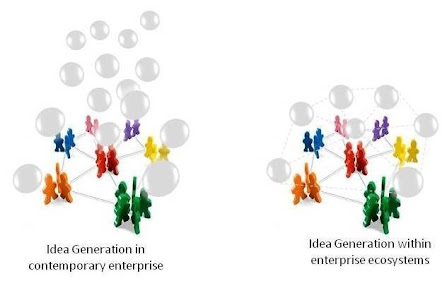Article first published as Operationalizing Enterprise Ecosystems on Technorati (PCX5DZB6CX25).
In the times of F.W. Taylor, focus of enterprise process was on repeatability and predictability and less on adaptability and agility. A hundred years later automation is pushing the monotonous functions to computer systems, using tools like self service solutions and straight through processing. As enterprises mature the role of the desk clerk who will come into work and do the same job day in and day out will be marginalized. Every employee will be empowered with the power to think, plan and execute in the new innovative enterprise.
The biggest challenge in being the innovative enterprise is in transitioning from conventional organization and systems to one that enables mass scale innovation, building the ability to tap into many little idea bubbles and aggregating them into new product or services that impact change in the way business gets done. My belief is this can be a achieved by establishing the right frameworks and tools or an Enterprise Ecosystems.
While this is the future, it is important to understand where organizations stand today and the direction in which they are evolving and why we are in a much better place to make that transition today than ever before.
Enterprise evolutionEnterprise strategy is conventionally driven top down, where the board decides the strategic direction, the annual and quarterly targets. The rest of the employees are expected to pretty much expand on the vision and execute. While this model has served the interests of rich boards and some overpaid CEOs does it really do justice to the true growth potential of an enterprise?
Ownership StructureThere was a time when organizations were started and owned by a few wealthy investors pooling their resources to start a company. As scale increased companies were restricted by the availability of capital. That changed with the advent of organized institutional finance and public capital markets. Ownership could rest in the hands of hundreds of thousands of investors driving up the scale of enterprise to heights never imagined before.
Management ControlConventional enterprises depended on a centralized command and control model where a small executive team that decided the fate of thousands of employees. Systems were designed to support a centralized chain of command and a pyramid style organization, with management and control that rested in the hands of few, restricting growth and innovation. As organizations spread across multiple geographies and became today’s mammoth, global enterprise, product lines and services had to be adapted to the culture, tastes and preferences of the local markets. Therefore control shifted to regional and countrywide command centers and thereby broadened the span of control and adaptability of the organization.
InnovationIf as in Fig 1.1, 80% of your organization was execution focused, 20% was ensuring goals set by the top 0.1-0.5% were met; the organization is wasting at least 80-90% of its intellectual potential. As the opportunities to innovate and generate value drops in the lower levels of the pyramid. This leads to typical idea bubble evaporation, where employees are forced to suppress ideas, either because they are so low down in the hierarchy to be heard or their job description doesn’t enable them to step out of bounds. Over time the lost bubbles cost organizations in terms of lost opportunities and employees who leave with their ideas to start off on their own or even worse hand it over to competition. The challenge can be addressed by creating the right Enterprise Ecosystems, a system that captures, develops and convert ideas into real world solutions.
A one hit wonder or sustained innovationIn the book The Element the author mentions an interesting anecdote where George Harrison one day got together with Bob Dylan and group of like minded musicians in a jamming session. What was a casual get together of music's greats resulted in Handle with Care which turned out to be Harrison’s greatest song in the post Beatles era. Is innovation truly a random event? Do we all have a Dylan or a Harrison in us? The answer in my mind varies based on what you set out to do. Do you want to be a one hit wonder or whether you want to create a system that consistently delivers? In an ideal world George Harrison and Bob Dylan should have got together and started one of the greatest rock bands after their album Traveling Wilburys but that never happened. That’s because what got them together did not keep them together. Traveling Wilburys was like an affair or a fling and had all the flair and charms of one. Innovation in the enterprise is not a fling; it’s about creating a sustainable and a constantly innovating enterprise.
An ecosystem is alive, dynamic, constantly evolving, nourishes growth and is supported by a strong community. Enterprise ecosystems create the internal mechanism for their employees to create new ideas and for like minded people to collaborate and build on it to the point where it can become a solution that justifies further investments. The idea can be a product, service, or even a new process. The ecosystem acts as a system that enables the identification, evolution and formalization of an idea into an offering. Further it is a culmination of tools that simplify collaboration, processes and systems that incubate ideas across the enterprise.
Enterprise Ecosystems and the innovation lifecycleIdea Generation
Create new offering
Reward Mechanism
Innovation cultureWhile a sizable reward is motivation for an innovator but the organization must have an innovation culture.












